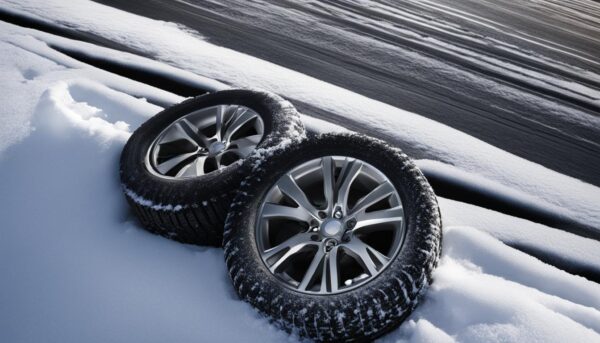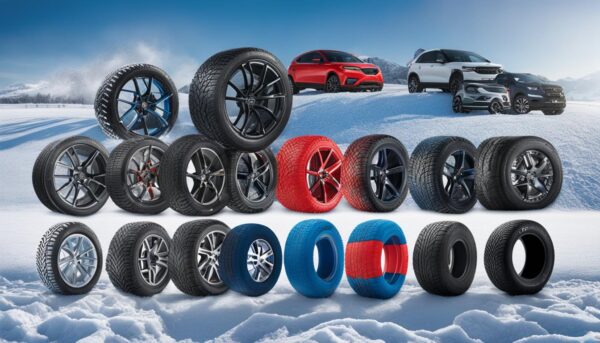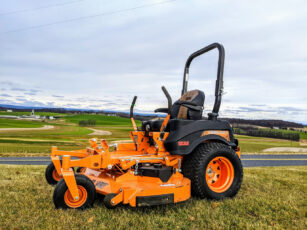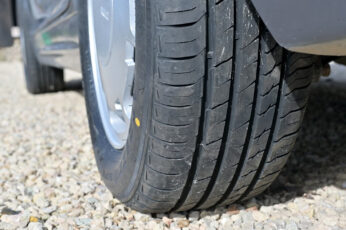Last Updated on 8 months
The Ultimate Guide to Installing Winter Tires at the Right Time
As winter approaches, drivers should prepare for icy roads and snow-covered streets. A crucial step in this process is installing winter tires on your vehicle. These tires are designed for optimal cold-weather safety, making them invaluable for navigating during the colder months. In this guide, experts from Tirecraft provide essential information on when and how to install winter tires and what to look for when choosing the best winter tire for your vehicle.
Key Takeaways
- Winter tires are necessary for safe driving in cold temperatures and snowy conditions.
- Temperatures consistently below seven °C (45°F) should trigger the switch to winter tires.
- Choose winter tires with appropriate tread depth and rubber compounds optimized for cold weather.
- Proper tire maintenance, including regular pressure checks, helps maximize winter tire efficacy.
- Select winter tires of the correct size for your vehicle and use complete sets for balanced driving dynamics.
- Follow specific guidelines for off-season storage to maintain the longevity of your winter tires.
- Investigate popular winter tire brands and their offerings, ensuring they adhere to safety designations and brand reliability.
Understanding the Importance of Winter Tires Over All-Season
Winter tire benefits extend beyond their ability to withstand freezing temperatures and winter road conditions. They are designed to provide optimal performance in cold weather, offering superior traction, control, and durability over all-season tires. The unique rubber compounds and tread patterns found in winter tires make them indispensable for safe driving during the winter months.
Temperature-Responsive Rubber Compounds
One critical benefit of winter tires is the use of temperature-responsive rubber compounds. These specially formulated compounds are designed to maintain flexibility and grip even in temperatures below seven °C (45°F), where all-season tires often harden and lose traction. This improved performance results in better control during braking, turning, and accelerating, significantly enhancing driver safety in colder months.
For instance, Quebec’s mandatory winter tire laws have been linked to significantly reducing injury-causing accidents during the winter season. This is a powerful testament to the importance of choosing the right tire for winter driving conditions.
Tread Patterns Designed for Snow and Ice
Another crucial aspect differentiating winter tires from their all-season counterparts is the diverse array of snow and ice tread patterns they possess. Winter tire treads, such as V-shaped patterns and deep grooves, are specifically engineered to effectively disperse snow and slush, promoting enhanced vehicle handling on snowy and icy roads.
- V-shaped patterns: Known for their water and slush expulsion properties, they rapidly channel water and slush away from the tire’s contact patch, maintaining a secure grip on the road.
- Deep grooves: The deep grooves found in winter tire treads provide increased biting edges, which enable the tires to grip more effectively on snowy and icy surfaces. This maximizes traction during acceleration, cornering, and braking.
“Winter tires, constructed with unique rubber compounds and specialized tread patterns, offer distinct advantages over all-season tires when it comes to driving in cold weather and winter road conditions.”
In summary, understanding the importance of winter tires over all-season tires is crucial for ensuring optimal driving safety during winter. With their temperature-responsive rubber compounds and specially designed snow and ice tread patterns, winter tires provide a substantial advantage in traction, handling, and overall vehicle performance in cold conditions.
Knowing the Best Time to Switch to Winter Tires
Timing is crucial for winter tires, specifically designed to perform optimally in colder temperatures. To determine the best time to install winter tires, consider two main factors: the onset of consistently low temperatures and the appearance of ice, sleet, or snow.
Experts recommend switching to winter tires when temperatures consistently drop below seven °C or 45°F. This is because winter tire compounds remain flexible in colder weather, which gives them better grip and vehicle stability than all-season tires, which become rigid and less effective in these conditions.
Tirecraft expert comments: “To benefit from winter tires’ enhanced performance, make sure to switch them out when the temperatures dip below 7°C or 45°F consistently.”
In addition to temperature, pay attention to weather forecasts and road conditions. Factors such as ice formation, significant snowfall, and prolonged periods of sleet or freezing rain can impact your driving experience. Installing winter tires before these conditions become severe can significantly affect safety and vehicle performance.
- Monitor the temperature: Transition to winter tires when the temperature consistently drops below seven °C or 45°F.
- Observe road conditions: Watch for ice, snow, and sleet.
- Watch weather forecasts: Stay informed about upcoming winter weather patterns and adjust your winter tire installation timing as necessary.
| Action | Reason |
|---|---|
| Switch to winter tires | Optimal performance in cold temperatures |
| Consider road conditions | Improved traction and grip on icy, snowy, or wet surfaces |
| Monitor weather forecasts | Anticipate and prepare for upcoming winter conditions |
Remember that switching back and forth between winter and all-season tires based on fluctuating temperatures is not advisable, as doing so can shorten the lifespan of your tires and incur additional costs. Instead, maintain a consistent tire type throughout winter to ensure optimum vehicle stability and safety.
The Essential Features of Quality Winter Tire Treads
Quality winter tire treads ensure optimal control and safety in winter driving conditions. The key factors to consider are measuring tread depth and understanding the benefits of directional treads and sipes. These elements significantly influence winter tire performance and handling in cold weather.
Measuring Tread Depth for Maximum Performance
To maintain excellent winter tire performance, it is essential to ensure that the tread depth is within the effective range of 20,000km to 25,000km of driving. A proper tread depth guarantees adequate traction and grip on snowy and icy surfaces. A straightforward method for assessing tread depth is the ‘Quarter Test’: if the top of the caribou’s nose on a quarter is visible when inserted into the tread, the tires may need replacement. This visual inspection can help you identify if your tracks are too worn for safe winter driving.
“Remember that proper tread depth is essential in maintaining control and grip on snowy and icy roads.”
The Benefits of Directional Treads and Sipes
Directional treads and sipes are two essential features contributing to the efficacy of winter tires. These design elements greatly influence how a tire responds to diverse winter road conditions, affecting overall performance and safety.
- Directional tread benefits: By incorporating V-shaped patterns, directional prints significantly enhance water and slush evacuation while driving, particularly in extreme weather conditions. This design element optimizes traction and tire functionality on slippery roads, facilitating smooth, responsive handling.
- Winter tire sipes: Sipes are minor grooves or channels that help disperse snow and slush from the tire’s contact patch while reducing braking distances on icy surfaces. Their presence improves acceleration and stopping power, ensuring superior control and increased safety while navigating challenging winter environments.
In conclusion, understanding the essential features of quality winter tire treads is crucial to optimizing your vehicle’s performance in winter conditions. By regularly measuring your tread depth and being aware of the benefits of directional treads and sipes, you can confidently navigate the season while ensuring your safety on the road.
Tire Pressure Checks: Crucial for Winter Tire Efficacy
Proper winter tire maintenance is indispensable to ensure a safe and smooth driving experience during cold weather. One critical aspect of tire care is conducting regular tire pressure checks. Cold temperatures can cause a decrease in tire pressure, which can adversely affect gas mileage, braking time, and overall tread life. In worst-case scenarios, incorrect tire pressure may even lead to tire failure.
For this reason, drivers should consistently monitor their tire pressure during the winter season. To do this, use a good-quality air pressure gauge and adhere to the pressure recommendations detailed on the tire’s sidewall. The manufacturer’s guidelines typically include that specific model’s optimal tire pressure range.
“To avoid causing any damage to your tires or putting your safety at risk, ensure that you check your tire pressure at least once a month during the winter months.”
Below are some essential steps to perform tire pressure checks correctly:
- Invest in a reliable air pressure gauge.
- Ensure your vehicle has been parked for at least three hours (or overnight) before checking the tire pressure.
- Locate the recommended tire pressure on the tire’s sidewall or in the owner’s manual.
- Remove the valve cap from the tire and attach the air pressure gauge to the valve stem.
- Compare the reading with the recommended pressure level provided by the tire manufacturer.
- If necessary, inflate or deflate the tire to reach the optimal pressure.
- Replace the valve cap once the tire pressure is adjusted correctly.
Implementing these guidelines will ensure your tires perform their best during winter and be crucial to winter tire maintenance. By consistently checking and adjusting your tire pressure, you can extend the lifespan of your tires and create a safer environment on the road for yourself and other drivers.
How to Select the Right Winter Tires for Your Vehicle
Choosing the right winter tires for your vehicle ensures optimal driving performance and safety during cold weather conditions. Two critical factors to consider when purchasing winter tires are compatibility and sizing. Furthermore, it is recommended that complete sets of winter tires be installed for enhanced stability and control.
Vehicle Compatibility and Sizing
To find the correct winter tire size for your vehicle, look for the tire sizing information on the driver’s side door frame or the tire sidewall. A tire size code typically includes a series of letters and numbers, offering essential information about the tire, such as width, aspect ratio, and diameter. It is crucial to winter tire compatibility and ensures optimal handling, avoiding potential safety hazards of an unstable driving experience.
Example of a tire size code: 205/55R16
205: tire width in millimeters
55: aspect ratio (tire height as a percentage of width)
R: radial construction
16: wheel diameter in inches
Why Full Sets Enhance Stability and Control
For optimal performance, particularly in braking, accelerating, and handling capabilities, it is recommended to install complete sets of winter tires. Mixing tire types can compromise ride quality and vehicle control, leading to potential safety risks. Full sets provide a well-balanced driving experience, ensuring each tire works together to achieve maximum stability and control during icy and snowy conditions.
| Advantages of Full Sets | Mixing Different Tire Types |
|---|---|
| Consistent traction and grip | Inconsistent traction and grip |
| Better handling in slippery conditions | Less predictable handling |
| Even wear across all tires | Uneven wear and reduced tire lifespan |
| Optimal braking and accelerating | Impaired braking and acceleration performance |
| Improved fuel efficiency | Decreased fuel efficiency |
Considering winter tire compatibility, tire sizing, and complete sets of winter tires ensures consistent vehicle performance, optimal handling, and enhanced stability and control during winter. With the right winter tires, you can confidently navigate snowy and icy roads, ensuring you reach your destination safely.
Directional vs. Symmetrical Treads: Which is Best for Winter Weather?

When selecting the right winter tires for your vehicle, it is essential to understand the critical differences between directional and symmetrical treads. Both have traits that improve performance in winter conditions. In this section, we will compare these winter tire tread types to help you choose the most suitable option for your needs.
As the name suggests, directional treads are designed to propel water, snow, and slush away from the tire’s centerline, providing enhanced traction and grip on wet or slippery surfaces. This is achieved by their distinctive V-shaped patterns and large grooves.
| Type | Description | Benefits |
|---|---|---|
| Directional Treads | V-shaped patterns and large grooves | Superior water and slush expulsion, better handling on snowy and icy roads |
| Symmetrical Treads | Uniform patterns across the entire tire width | Improved fuel efficiency, quieter ride, and longer lifespan |
Alternatively, symmetrical treads feature a consistent tread pattern in the whole tire width. While they may not provide the same level of winter performance as directional treads, their primary advantages lie in improved fuel efficiency, a quieter ride, and a longer lifespan due to their even wear throughout the tire’s lifetime.
So, which tread type is ideal for winter weather? The answer ultimately depends on your priorities as a driver.
If winter performance and safety are your top concerns, directional treads are the recommended choice due to their superior handling capabilities on snowy and icy roads.
However, conventional symmetrical treads may be more appealing if you value fuel efficiency and a longer-lasting tire. Before deciding on the right winter tire tread type, consider your driving habits, vehicle weight, and typical road conditions.
Studded Tires: Are They Permitted and Beneficial?
When considering the use of studded tires during winter months, it is essential to understand the associated regulations and benefits. These tires offer superior traction on icy roads compared to their non-studded counterparts. However, studded tires are subject to regional winter tire regulations due to their potential impact on road conditions and increased noise levels.
Studded tire legality varies across Canada, with restrictions based on provinces and timeframes for permissible use.
As the regulations concerning studded tires differ from region to region, verifying their legality in your area is crucial to avoid penalties.
Studded tires are specifically designed with metal studs that protrude from the tire tread, creating better grip and traction on hard-packed snow and icy surfaces. Despite their advantages, they can be relatively noisy and contribute to increased road wear when not used in freezing conditions or during restricted periods.
- Enhanced Traction: Metal studs on studded tires provide superior grip on icy or hard-packed snow surfaces.
- Noise Levels: Due to the metal studs, studded tires can produce considerable noise, especially on dry roads.
- Road Impact: Studded tire use can increase wear on road surfaces, leading to regulatory restrictions in certain areas.
When deciding whether to use studded tires, it is essential to weigh the benefits against potential drawbacks and adhere to regional guidelines. If studded tires are permitted in your area, and the conditions warrant their use, they may significantly improve safety and vehicle control on icy roads during winter.
Evaluating Popular Winter Tire Brands and Their Offerings

When selecting winter tires, it is essential to look for the Severe Service Winter Tire Designation and choose trusted brands. Although specific brand evaluations are not provided, your selection should be based on adherence to safety designations and brand reliability. Below is a list of reputable winter tire brands and some of their popular offerings.
Consider the following table, which provides a brief outline of popular winter tire models for each brand and their notable features:
| Brand | Model | Notable Features |
|---|---|---|
| Michelin | Michelin X-Ice Xi3 | Improved grip, low rolling resistance, and long-lasting tread life |
| Bridgestone | Bridgestone Blizzak WS90 | Excellent traction in snow and ice, uniform warranty, and a comfortable ride |
| Continental | Continental WinterContact SI | PolarPlus+ Technology for reliable grip, responsive handling, and shorter stopping distances |
| Goodyear | Goodyear Ultra Grip Ice WRT | 3D TredLock Technology for improved handling and hydroplaning resistance |
| Pirelli | Pirelli Winter Sottozero 3 | Improved braking performance and handling on wet and dry roads |
Before making a decision, you should also consider winter tire recommendations from friends, family, and professionals in the automotive industry. They might have valuable insights on performance, durability, and cost-effectiveness based on their experience with various winter tire brands and models.
Remember, choosing the right winter tires is essential to maintain optimal safety and control during the cold months. Always opt for brands and offerings that have been tried and tested for their performance and reliability, ensuring a safe driving experience in snowy and icy conditions.
Winter Tire Maintenance Tips for Off-Season Storage
As the winter season ends, it’s essential to properly store your winter tires to maintain their durability and performance. By following these winter tire maintenance and off-season storage tips, you can preserve your winter tires until they’re needed again.
Proper Cleaning and Storing Techniques
Before storing your winter tires, it’s critical to clean them thoroughly. Dirt, debris, and road salt can cause damage and deterioration to the rubber if left unattended. Use the following steps to ensure proper cleaning:
- Remove the wheels from your vehicle, taking note of their positions.
- Wash each tire using a mild soap, water, and a soft brush to remove dirt and debris.
- Rinse the tires thoroughly and let them air dry to avoid trapping moisture.
Once the tires are clean and dry, utilize these storage techniques to protect them until next winter:
- Store tires in a cool, dry, and dark space to minimize exposure to sunlight, moisture, and extreme temperatures.
- Place the tires in protective bags or covers to shield them from dust and contaminants.
- Keep the tires on separate rims if possible, making it easier to switch them out next winter.
- Stack the tires horizontally or vertically on a storage rack, being cautious not to stack too high.
In addition to proper cleaning and storage, consider conducting periodic inspections while your winter tires are in off-season storage to check for any damage or deterioration that might have occurred.
By following these essential winter tire maintenance and storage tips, you can extend the lifespan and performance of your winter tires, ensuring a safer and more dependable driving experience throughout the cold months.
Conclusion
In conclusion, adopting proper winter tire safety measures is essential for a safer driving experience during the cold months. Our comprehensive guide walks you through everything you need about installing winter tires. From understanding the importance of winter tires to selecting the right ones for your vehicle, this winter tire buying guide helps ensure optimal cold-weather safety on the roads.
Key takeaways from this guide include the optimal timing for winter tire installation, the benefits of choosing appropriate tire types and sizes, and the importance of maintaining tire condition with regular tire pressure checks and sufficient tread depth. By following these guidelines, drivers can improve their driving experience in winter conditions and contribute to safer roadways for everyone.
Investing in quality winter tires and taking care of them with proper off-season storage and maintenance can ensure their performance and longevity for years. Make informed decisions regarding winter tires, and stay safe on the roads this winter!
FAQ
What are the main differences between winter tires and all-season tires?
Winter tires are constructed using specialized rubber compounds designed to function below seven °C, maintaining flexibility and grip, while all-season tires can become rigid and lose traction in colder temperatures. Winter tires also have distinct tread patterns for better handling on snowy and icy roads. In contrast, all-season tires are designed for various road conditions but may not deliver optimal performance in winter weather.
When should I install winter tires on my vehicle?
The transition to winter tires should happen when temperatures consistently drop below seven °C or 45°F. This ensures that your winter tires maintain flexibility and provide better handling and stability in cold weather, compared to all-season tires that may become rigid and less effective.
How do I measure the tread depth of my winter tires?
Tread depth is vital for winter tire performance. To measure the tread depth, use the ‘Quarter Test’: insert a quarter into the tread with the caribou’s nose pointing down. If the top of the caribou’s nose is visible, it may be time to replace your winter tires.
Why is tire pressure essential for winter tire performance?
Proper tire pressure is essential during winter as cold air can cause a decrease in tire pressure, negatively affecting gas mileage, braking time, and overall tread life and potentially leading to tire failure. Use an air pressure gauge and follow the pressure recommendations on your tire’s sidewall to maintain optimal pressure.
How do I choose the right winter tires for my vehicle?
Ensure that the winter tires you select are compatible with your vehicle’s make and model. Check the driver’s side door frame or the tire sidewall for the proper tire size. It is also recommended that winter tires be installed in complete sets of four to maintain consistent vehicle braking, acceleration, and overall handling performance.
What should I consider when evaluating different winter tire brands and their offerings?
When selecting winter tires, look for the Severe Service Winter Tire Designation and use trusted brands. While specific brand evaluations may not be provided, consider factors such as adherence to safety designations and overall brand reliability.
How should I store my winter tires during the off-season?
To store your winter tires properly, clean them thoroughly and keep them in a dry place. Temperature and humidity conditions should be conducive to preserving the tires until the next winter season. You may also use tire bags or covers for additional protection, so consider keeping them on separate rims for easy swapping.













 Français
Français Español
Español